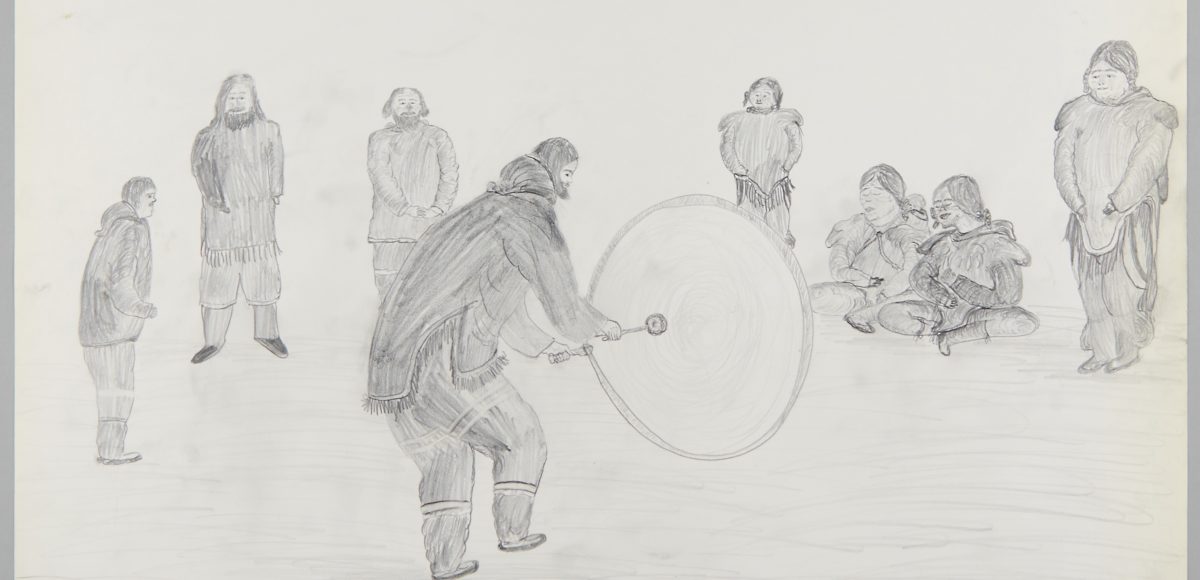An art exhibition at the Canadian Museum of History is unique in that the people who made it were not artists at all.
The exhibition, Picturing Arctic Modernity — Northern Baffin Drawings from 1964, includes 50 drawings gathered by Terry Ryan 54 years ago. Ryan, who for many years was general manager at the renowned print studio in Cape Dorset, feared “the loss of traditional Inuit culture in the face of social change,” say exhibition notes, so in 1964 “he travelled by plane and dogsled to the North Baffin Island communities of Clyde River, Pond Inlet and Arctic Bay.” Ryan gave paper and pencils to more than 150 adults and children, and they created 1,842 drawings of their lives, land and stories.
The artists ranged in age from seven to 72, and the artistic skill level is equally broad. Even by the looseness of much untrained work, these drawings reveal great and whimsical liberties with perspective and scale. This adds to their appeal, as they were created not as an artistic accomplishment, but as a sociological and anthropological testament to times past, and to a gnawing angst for the future. Picturing Arctic Modernity is an exercise more expository than aesthetic, and there is much in it to see and learn.
“A lot of them were just regular folks (drawing) interpretations and reflections without any sort of eye to what the southern market wanted,” says Linda Grussani, the museum’s curator of aboriginal art.
The exhibition begins with practical insights, such as Things Left for Us from the Old Times, a rough, hand-drawn inventory of quotidian objects — needles, pots and other items that can be seen as actual artifacts elsewhere in the museum. Another drawing shows approximately 50 precisely cut pieces of caribou skin, to be sewn into a parka with leggings and boots.
“It’s the ingenuity of the individuals,” Grussani says. “Patterns were never made in advance, they would have been memorized and cut to size without the use of a measuring tape — a tremendous technical and intellectual undertaking.”
There are images of apparent sentimentality, such as in Different Homes We’ve Had, with its progression of building styles and materials. “This is a Qaluaaq’s (white person’s) house (top),” writes Mary Tassugat, who made the drawing. “This is an Inuit tent (middle). It is made of sealskins and harp sealskins, and (is) used during the spring and summer. This is an iglu (bottom), used during winter. It was warm when it was built right.” The words, like the lines on the paper, are economical and direct, without obvious sentiment, so perhaps what’s apparent is a projection of my Qaluaag nature.
Throughout the exhibition, the drawings are heavy with text, all written in Inuktitut and translated into French and English in a guide that visitors can carry during their tour.
Entertaining stories abound in the third section. Some are inexplicable — of the drawing Strange Scene, “Here are men reaching to the small woman, who is bathing nude in a little pond. Her child is reaching for her. Inuit nowadays out here are wealthy . . . The husband and wife: his wife is wearing a cape, and her husband is beside a shadow.”
Others are simply thrilling, such as Climbing a Cliff Face to Collect Eggs in a Teapot, or incredible, such as a visualized memory of “tormenting a polar bear.” There are videos throughout the exhibition, and the now-elderly Jacob Peterloosie, who made the drawing 54 years ago, recalls the dangerous encounter his friends and he had with the world’s biggest land predator. Peterloosie speaks in Inuktitut, which brings another elemental insight into the Inuit world.
One drawing is Pretending to Be Strong for Outsiders, and it shows Inuit tossing inflated seal skins into the air, so outsiders would witness this feat and believe the Inuit had the enormous strength to toss boulders about.
Potemkin seals? Such are the things to be learned in this intimate window of a distant time and place, and the people who live there still.
Picturing Arctic Modernity continues to Sept. 3.






